Lucinda Devlin
Photographic series by Lucinda Devlin
My work as an artist has been exploring contemporary American culture through the psychologically complex domain of interior spaces. I have found that spatial settings can provide unique cultural readings on how spaces, objects and artifacts can construct meaning.
I explore these ideas through series of pictures which collectively define many of the mores, values or beliefs of large segments of the American culture. I feel the photographs contain rich layers of information enabling them to be viewed and interpreted in numerous ways.
A conversation with Lucinda Devlin and curator Elaine Gustafson in occasion of the exhibition "Sightlines" at the Weatherspoon Art Museum, Greensboro, 2017
I explore these ideas through series of pictures which collectively define many of the mores, values or beliefs of large segments of the American culture. I feel the photographs contain rich layers of information enabling them to be viewed and interpreted in numerous ways.
A conversation with Lucinda Devlin and curator Elaine Gustafson in occasion of the exhibition "Sightlines" at the Weatherspoon Art Museum, Greensboro, 2017
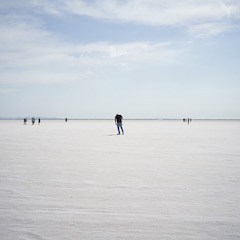
Salt
Bonneville Salt Flats, Utah #9,
Utah, 2021
Bonneville Salt Flats, Utah #9,
Utah, 2021
Devlin's Salt series, which was shot in the Great Salt Lake Desert in Utah, "revolves around the interplay of water, sky, ground surface, and atmosphere, like a topographical investigation of a region with an extraordinary geological makeup. This region, too, is now threatened by harmful environmental influences. The Great Salt Lake keeps loosing water, causing salinity levels to rise and the fragile ecosystem to falter. Against this backdrop, Devlin's aesthetically pleasing color photographs with their well-balanced compositions may seem almost like a memento mori. The beauty of the earth once again unfolds here before our eyes, giving us a sense of infinity when the subtext has long been something else entirely."
Claudia Schubert, Die Photographische Sammlung, SK-Stiftung Kultur
Claudia Schubert, Die Photographische Sammlung, SK-Stiftung Kultur
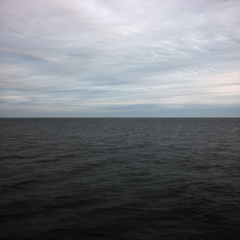
Lake Pictures,
Lake Huron,
May 10, 2011
Lake Huron,
May 10, 2011
Lake Pictures is a series of photographs of Lake Huron, one of the Great Lakes surrounding the state of Michigan, taken at the same place, during different seasons, and at different times of day or night, exploring the changing atmospheric nature of the lake. These pictures are about water, sky ,color, light, place, space and time.
When we look at a large body of water, intellectually we know that there is more water beyond the horizon. If we suspend our intellects, our mind's eye perceives the water as occupying infinite space.
The same concept is true regarding the sky. It appears limitless.
The way we can distinguish between the two is the fine demarcation line of the horizon that separates water from sky.
The thin line of the horizon defines the immensity of infinite space between these two boundless elements. The viewer is visually pulled into the photographs by the line where the two environments converge.
Exhibition Lake Pictures at Galerie m Bochum, 2015
When we look at a large body of water, intellectually we know that there is more water beyond the horizon. If we suspend our intellects, our mind's eye perceives the water as occupying infinite space.
The same concept is true regarding the sky. It appears limitless.
The way we can distinguish between the two is the fine demarcation line of the horizon that separates water from sky.
The thin line of the horizon defines the immensity of infinite space between these two boundless elements. The viewer is visually pulled into the photographs by the line where the two environments converge.
Exhibition Lake Pictures at Galerie m Bochum, 2015
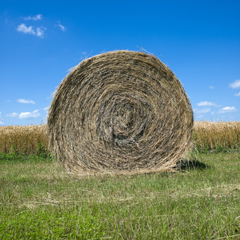
Field Culture
Hay Bale, South Dakota,
2008
Hay Bale, South Dakota,
2008
Finding herself once again living back on home ground in the Midwest of America, Devlin has moved out of her interiorscapes into outdoor environments. In Field Culture she explores the multifaceted milieus of modern day farming including high tech farm machinery, biogenetics, biofuels, and windpower.
The landscapes of the American Midwest form a quiet counterpoint to the more dramatic western landscapes of Watkins and O’Sullivan, and later Adams. But anyone who has driven through Iowa in July can’t help but be carried away by the seductive lushness and sheer beauty of corn and soybean fields in full vigor.
The landscapes of the American Midwest form a quiet counterpoint to the more dramatic western landscapes of Watkins and O’Sullivan, and later Adams. But anyone who has driven through Iowa in July can’t help but be carried away by the seductive lushness and sheer beauty of corn and soybean fields in full vigor.
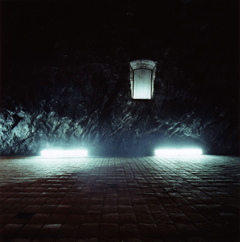
Subterranea
Salt Cathedral #2,
Colombia 1985
Salt Cathedral #2,
Colombia 1985
Devlin has traversed the continents for over 20 years now to photograph hidden subterranean caverns. The resulting series Subterranea, which she first compiled in 2006, includes photos of radon galleries with purported healing powers in Germany, American caves that have been turned into tourist attractions, the “Salt Cathedral” in Colombia, a glacier atop the Matterhorn in Switzerland et al.
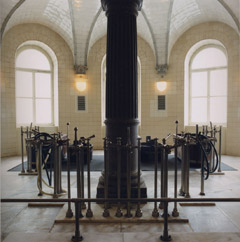
Water Rites
Hydrotherapie, Friedrichsbad,
Baden-Baden, 1999
Hydrotherapie, Friedrichsbad,
Baden-Baden, 1999
Water Rites explores current day Kurbaden in Germany which has a highly developed network of spas offering medicinal and health benefits through a variety of curative measures including massage, hydrotherapy, and physical therapy. These curing baths have long flourished under a system of state supported health insurance, but many have now found it necessary to change due to a reduction in those benefits.
Water Rites is a continuation of the ideas generated by Corporal Arenas and
The Omega Suites. Whether it is a lethal injection chamber, a surgical operating theatre, or a water therapy room, the body becomes an entity controlled by forces outside of itself. But it is in spa treatments where we begin to see a confluence of the discomfort associated with medicine and the pleasure associated with beauty treatments.
Water Rites is a continuation of the ideas generated by Corporal Arenas and
The Omega Suites. Whether it is a lethal injection chamber, a surgical operating theatre, or a water therapy room, the body becomes an entity controlled by forces outside of itself. But it is in spa treatments where we begin to see a confluence of the discomfort associated with medicine and the pleasure associated with beauty treatments.
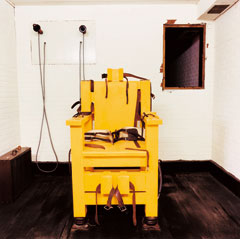
The Omega Suites
Electric Chair,
Holman Unit, Atmore, Alabama, 1991
Electric Chair,
Holman Unit, Atmore, Alabama, 1991
The activities carried out in The Omega Suites require the ultimate in passivity. Originally, it was this progression from Corporal Arenas that brought me to execution rooms. I found a great similarity between the spaces designed for healing and those designed for killing. These pictures were not intended as a polemic against the death penalty. But soon, the project took on a life of it's own and I became totally obsessed with this world of execution. And so I set out to find out all I could about the people and institutions and the accoutrements and rituals of this death work.
All images of the series The Omega Suites
All images of the series The Omega Suites
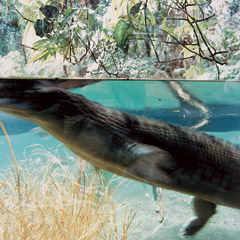
Habitats
Gharial Exhibit, Bronx Zoo,
New York 1987
Gharial Exhibit, Bronx Zoo,
New York 1987
In the series Habitats and Corporal Arenas, it seems that others are in control. Habitats continues to explore man-made environments, but those which are created for captive animals. Our ironic attempts to artificially reproduce vanishing ecosystems as well as the exploitation of animals in theme parks and tourist attractions reflect attitudes toward animal life and the natural world in general that are currently in a state of transition.
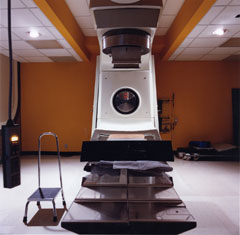
Corporal Arenas
Cancer Research Hospital, Rochester
New York, 1987
Cancer Research Hospital, Rochester
New York, 1987
Corporal Arenas specifically addresses the mythology that surrounds the spaces apparatus and technology present in the treatment of the body. The tools are designed to fuction but appear to be cool, imposing, dominating. These spaces force passivitiy, which makes us feel frightened and vulnerable.
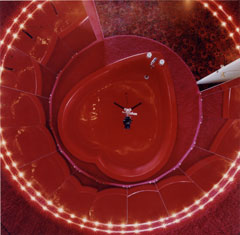
Bath, Pocono Palace, Marshall's Creek,
Pennsylvania, 1980
Pennsylvania, 1980
Pleasure Ground explores contemporary environments which have been designed primarily for the appeal of the middle class. These interiors have been specifically constructed, sometimes elaborately, for the pursuit of a myriad of pleasures and exemplify modernist thought about design and materials in what has become a "throwaway", transient culture. These spaces carry an underlying code, a promise of pleasure. People who engage in the activities suggested by these rooms are in control; they choose to participate and are therefore pro-active in their pursuit of pleasure.
